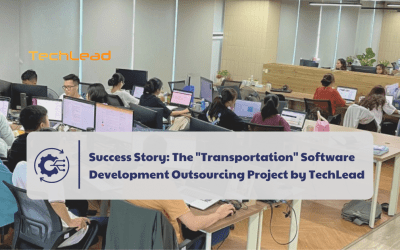In today’s technology-driven world, IT outsourcing is essential for businesses to improve efficiency and innovation by leveraging external expertise and resources. This blog post explores all about IT outsourcing.
Definition and basic concepts of IT outsourcing
1. Concept of IT outsourcing and related definitions
IT outsourcing refers to the practice of contracting specific IT functions or services to external third-party providers. This strategic business decision allows organizations to leverage external expertise and resources, typically to reduce costs, improve efficiency, and focus internal resources on core business activities. Commonly outsourced IT functions include software development, technical support, network management, and infrastructure maintenance. By engaging with specialized IT service providers, companies can benefit from access to advanced technologies, industry best practices, and scalable solutions tailored to their operational needs.
2. Recent developments and trends of IT outsourcing
In recent years, IT outsourcing has witnessed significant growth and evolution driven by global economic trends and technological advancements. Organizations increasingly embrace outsourcing to adapt to dynamic market demands, mitigate operational risks, and accelerate innovation. The rise of cloud computing, digital transformation initiatives, and the demand for specialized IT skills have further fueled the adoption of outsourcing models. Companies are exploring diverse outsourcing options such as onshore, offshore, and nearshore outsourcing to capitalize on cost efficiencies, access global talent pools, and enhance operational flexibility. This trend reflects a strategic shift towards agile business models that prioritize scalability, agility, and cost-effectiveness in IT operations.
3. Main benefits of using IT outsourcing services
The primary benefits of IT outsourcing are manifold and cater to diverse organizational objectives. Firstly, outsourcing enables companies to streamline operations and achieve cost savings through reduced overhead expenses and access to competitive pricing structures offered by external providers. Secondly, it facilitates access to specialized expertise and advanced technological capabilities that may not be feasible to develop in-house. Thirdly, outsourcing fosters operational efficiency by allowing organizations to focus internal resources on core competencies and strategic initiatives, thereby enhancing overall productivity and innovation. Additionally, outsourcing can provide operational scalability, enabling businesses to quickly adapt to changing market conditions and scale IT resources as needed. Ultimately, IT outsourcing empowers organizations to achieve operational excellence, mitigate risks, and maintain competitive advantage in an increasingly digital-centric business environment.
Popular types of IT outsourcing
1. IT Outsourcing Types: Onshore, Offshore, and Nearshore
IT outsourcing encompasses various models tailored to meet specific business needs and cost considerations. Among the most prevalent are onshore, offshore, and nearshore outsourcing.
Onshore Outsourcing: This model involves delegating IT functions to service providers within the same country or geographical region as the client company. Onshore outsourcing offers advantages such as cultural alignment, easier communication, and potentially lower risks associated with regulatory compliance and data security. Companies opting for onshore outsourcing typically prioritize proximity for closer collaboration and regulatory adherence.
Offshore Outsourcing: In contrast, offshore outsourcing involves contracting IT services to providers located in a different country, often characterized by significant geographical distance. The primary appeal of offshore outsourcing lies in cost efficiency, leveraging lower labor costs and accessing a broader talent pool. However, challenges such as time zone differences, cultural and language barriers, and regulatory compliance complexities must be effectively managed to ensure seamless operations and data security.
Nearshore Outsourcing: Nearshore outsourcing strikes a balance between onshore and offshore models by contracting IT services to neighboring or nearby countries. This approach combines proximity advantages with cost savings, offering businesses the opportunity to benefit from cultural affinity, reduced travel time, and similar time zones. Nearshore outsourcing is particularly advantageous for companies seeking cost-effective solutions while maintaining operational flexibility and minimizing logistical challenges.
2. Managed Services and Project-Based Outsourcing
Managed Services: Managed services involve outsourcing the management of specific IT functions to a third-party provider. This model allows organizations to offload responsibilities such as network management, cybersecurity, data backup, and technical support to specialized experts. Managed services providers (MSPs) typically operate on a subscription or service-level agreement (SLA) basis, ensuring proactive monitoring, maintenance, and optimization of IT infrastructure. Businesses benefit from enhanced operational efficiency, reduced overhead costs, and access to advanced technologies without the need for extensive in-house resources.
Project-Based Outsourcing: Project-based outsourcing revolves around engaging external vendors to deliver defined IT projects or initiatives within a specified timeframe and budget. This approach is ideal for businesses requiring specialized expertise or additional resources to execute projects such as software development, system integration, or infrastructure upgrades. Project-based outsourcing offers flexibility in scaling resources according to project requirements, mitigates risks associated with project delays or resource shortages, and facilitates cost predictability through fixed-price or milestone-based contracts.
3. Cloud Outsourcing and IT Staff Augmentation
Cloud Outsourcing: Cloud outsourcing involves outsourcing IT services and infrastructure management to cloud service providers (CSPs). Organizations leverage cloud computing resources, including infrastructure as a service (IaaS), platform as a service (PaaS), and software as a service (SaaS), delivered over the internet. Cloud outsourcing offers scalability, flexibility, and cost efficiency by eliminating the need for on-premises hardware investments and maintenance. Businesses benefit from rapid deployment, enhanced accessibility, and seamless integration with existing IT ecosystems, empowering innovation and agility in response to evolving business demands.
IT Staff Augmentation: IT staff augmentation entails supplementing existing in-house IT teams with external resources to address skill gaps, accelerate project timelines, or manage peak workloads. This model allows businesses to access specialized expertise and experience without the long-term commitment or overhead costs associated with full-time hires. IT staff augmentation providers offer on-demand access to professionals skilled in areas such as software development, cybersecurity, data analytics, and IT infrastructure management. Organizations gain flexibility in resource allocation, improve project scalability, and optimize operational efficiency while maintaining control over project outcomes and strategic priorities.
These models of IT outsourcing cater to diverse organizational needs, enabling businesses to optimize operational efficiency, reduce costs, and leverage specialized expertise to drive innovation and competitive advantage in a rapidly evolving digital landscape.
IT outsourcing implementation process
IT outsourcing is a crucial strategy for businesses aiming to optimize costs and focus on their core operations. The implementation process of IT outsourcing involves several meticulous steps to ensure effectiveness and client satisfaction.
1. Identifying the needs and objectives of the business.
This requires thorough analysis of what needs to be outsourced, ranging from software projects to technology infrastructure and technical support. Understanding these needs helps businesses choose the most suitable IT outsourcing partner.
2.Selecting the IT outsourcing service provider.
This involves more than just choosing a provider with low costs; it entails considering their ability to provide services that align with the specific needs of the business. Factors such as experience, ability to adapt to new technologies, and capability to ensure product quality are critical considerations.
3.Designing the strategy and contract
This includes developing a detailed plan on work methodologies, quality standards, and commitments regarding time and costs. The contract needs to be clear and transparent to avoid misunderstandings and disputes during project implementation.
4.Implementation and transfer
This is the most critical stage in the IT outsourcing process, where all planned activities are executed and the final product or service is handed over to the business. This requires close coordination between the in-house team and the outsourcing provider to ensure continuity and quality of the end product.
5.Managing and evaluating effectiveness
After implementation, management and evaluation are conducted to ensure that set goals are achieved and that operations remain effective. This involves reviewing the implementation process, addressing any issues that arise, and making improvements to optimize IT outsourcing services in the future.
In conclusion, the IT outsourcing implementation process is not just about transferring work to an external partner but is a complex journey that requires depth and rigor in each investment and execution step. By adhering closely to these steps, businesses can reap significant benefits from applying IT outsourcing to their operations.
Challenges and Strategies in IT Outsourcing
1. Information Security and Risk Management
Information security remains a paramount concern in IT outsourcing engagements. Entrusting critical business processes and sensitive data to external providers introduces inherent risks such as data breaches, unauthorized access, and compliance failures. Effective risk management strategies are essential to mitigate these threats. This involves rigorous due diligence during vendor selection, ensuring compliance with industry standards and regulations (e.g., GDPR, HIPAA), and establishing robust contractual agreements that outline data protection measures, incident response protocols, and liability provisions. Continuous monitoring and audits are also crucial to maintain security posture throughout the outsourcing lifecycle. By implementing comprehensive security frameworks and fostering a culture of vigilance, organizations can bolster resilience against evolving cyber threats and safeguard their intellectual property and customer data.
2. Geographic and Cultural Distance Management
Managing geographical and cultural differences presents significant challenges in IT outsourcing projects. Remote teams operating across different time zones and cultural backgrounds may encounter communication barriers, misunderstandings in project requirements, and varying work ethics. These factors can lead to delays, misalignment of expectations, and diminished productivity. To address these challenges, effective communication strategies and collaboration tools are indispensable. Regular video conferences, virtual project management platforms (e.g., Jira, Trello), and culturally sensitive training programs help bridge gaps and foster a cohesive team environment. Establishing clear communication channels, defining roles and responsibilities, and promoting cultural awareness among team members promote mutual understanding and synergy. Additionally, periodic onsite visits and team-building activities can enhance rapport and trust among distributed teams, fostering a collaborative and productive outsourcing ecosystem.
3. Strategies and Tips for Successful IT Outsourcing Implementation
Successful IT outsourcing implementation hinges on strategic planning, proactive management, and adaptive leadership. Key strategies include:
- Clear Goal Setting: Define specific objectives, expected outcomes, and measurable key performance indicators (KPIs) to align outsourcing initiatives with organizational goals.
- Comprehensive Vendor Selection: Conduct thorough due diligence to evaluate vendor capabilities, track record, financial stability, and cultural fit. Seek references and conduct site visits to assess operational readiness and service delivery capabilities.
- Structured Governance Framework: Establish a governance framework with defined roles, responsibilities, and escalation procedures to ensure accountability and transparency. Regular performance reviews and service level agreement (SLA) monitoring ensure compliance and quality assurance.
- Continuous Improvement: Foster a culture of continuous improvement by soliciting feedback, implementing lessons learned, and adapting processes based on evolving business needs and technological advancements.
- Risk Mitigation: Implement robust risk management practices, including contingency planning, disaster recovery strategies, and cybersecurity measures to safeguard against potential disruptions.
- Effective Change Management: Proactively manage organizational change by involving stakeholders, communicating effectively, and addressing resistance to ensure smooth transition and adoption of outsourced services.
By leveraging these strategies and adhering to best practices, organizations can mitigate risks, optimize operational efficiencies, and achieve sustainable competitive advantages through successful IT outsourcing initiatives.
TechLead – A reputable IT outsourcing service provider

TechLead takes pride in its distinguished reputation as a premier software development consulting service provider, boasting over 6 years of dedicated experience in the industry. Our impeccable track record stands as a testament to our unwavering commitment to delivering excellence. Backed by a team of seasoned professionals, we are steadfast in our mission to offer the most dedicated and effective software development consulting services available in Vietnam.
Partnering with TechLead offers numerous benefits tailored to meet your business needs:
- 24/7 Support: Our commitment to your success extends around the clock, ensuring prompt assistance and resolution of any issues, regardless of time or location.
- Quick Start: Projects can commence within an expedited time frame of just 1-3 business days, allowing for swift initiation and accelerated project timelines.
- Flexible Collaboration: We synchronize our working hours with your time zone, fostering seamless communication and efficient project progress to meet deadlines effectively.
- Extensive Expertise: With deep proficiency across various domains, we possess the capabilities to fulfill diverse requirements and tackle complex challenges with precision and innovation.
- Excellent Engineer Team: Our team comprises top-tier software engineers, ranking within the top 1% in Vietnam. Their exceptional skills and dedication ensure the delivery of solutions of unparalleled quality and reliability.
At TechLead, we combine technical expertise with a client-centric approach to drive transformative outcomes for businesses. Whether you’re embarking on a new software initiative or seeking to optimize existing systems, our commitment to excellence and customer satisfaction remains unwavering. Experience the difference with TechLead and unlock the full potential of your software development projects with confidence and precision.
Conclusion
In summary, IT outsourcing encompasses the strategic use of external service providers to deliver IT-related tasks and functions, allowing businesses to focus on core competencies and reduce operational costs. The practice has evolved significantly, with businesses leveraging onshore, offshore, and nearshore outsourcing models to achieve flexibility and cost-efficiency. Managed services and project-based outsourcing provide tailored solutions for ongoing operational support or specific project needs, respectively. Cloud outsourcing has emerged as a pivotal option, offering scalable and accessible IT infrastructure solutions. Despite its benefits, IT outsourcing presents challenges such as data security risks and managing geographical and cultural differences. Successful implementation hinges on meticulous provider selection, strategic planning, and effective project management. Therefore, businesses are urged to explore and implement IT outsourcing to optimize costs, enhance capabilities, and meet the growing demands of technological advancement.
TECHLEAD – Leading technology solution for you!
Hotline: 0372278262
Website: https://www.techlead.vn
Linkedin: https://www.linkedin.com/company/techlead-vn/
Email: [email protected]
Address: 4th Floor, No. 11, Nguyen Xien, Thanh Xuan, Hanoi





